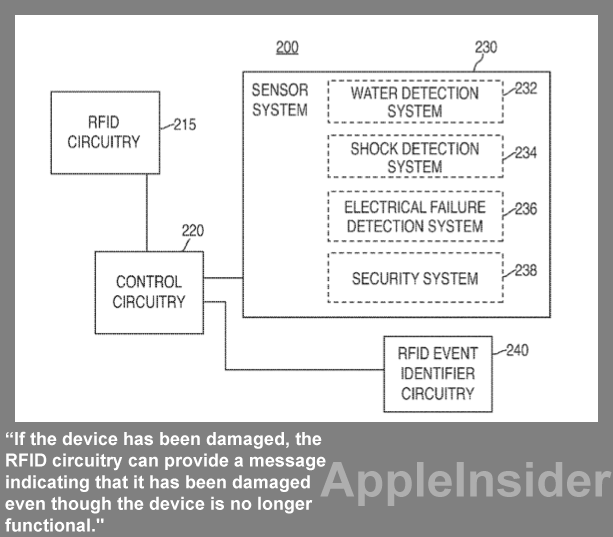RFID chips could act like an airplane 'black box' for Apple's future iPhones
The concept, much like a durable "black box" found in an airplane that stores crucial data in the event of a crash, was revealed this week in a new patent application published by the U.S. Patent and Trademark office. Discovered by AppleInsider on Thursday, it is entitled "RFID Circuitry and Methods of Using the Same to Provide Information of Events Pertaining to an Electronic Device."
The proposed invention notes that radio-frequency identification (RFID) circuitry can be used in a variety of different methods, and gives examples of it being utilized with highway tolls, inventory management, badge entry, public transportation, and wireless transactions.
In those examples, RFID circuitry in a device, like an iPhone, provides information to an RFID reader. But that information is usually "fixed," sharing information that does not usually change, such as a credit card number or unique identifier.
Apple's proposed invention would use RFID circuitry to selectively provide different, dynamic information as needed. In this way, the data being shared by an RFID chip in an iPhone could be modified to communicate variable information.
In the most obvious examples, the data shared could be basic information like the last song played on an iPhone, or a notification to an external reader that a new text message has been received. But Apple could also employ RFID to retrieve information from an iPhone with hardware that is no longer operational.
The filing goes on to describe how the RFID circuitry could share with an external reader any "events" that may have occurred within the device. In one example, a "trigger event" could be detected by a sensor like a water detection system.
Other examples include a shock detection system in the event that an iPhone is dropped, an electrical failure detection system to record circuitry problems, and a general security system that could potentially detect general tampering with the device.
By using passive RFID circuitry, an iPhone could wirelessly provide NFC data even when it is powered off, disabled, or operating in a low-power state.
"This enables the device to provide passive messages without incurring any substantial energy cost," the filing reads. "For example, if the device has been damaged, the RFID circuitry can provide a message indicating that it has been damaged even though the device is no longer functional."
Apple's system would include a variety of potential event scenarios stored on the device. This way, the system could more quickly select an appropriate message to broadcast over RFID before a device becomes nonfunctional.
The application, disclosed this week, was first filed in March of 2010. It is credited to Tyler Mincey and Andrew Hodge.
Apple's interest in RFID technology has been well-documented, though most evidence of NFC chips potentially appearing in an iPhone have been related to more conventional uses of the technology, like e-wallet transactions or tag readers. But the company's latest proposed invention represents a more unique application of RFID technology in mobile devices.
 Neil Hughes
Neil Hughes











 William Gallagher and Mike Wuerthele
William Gallagher and Mike Wuerthele
 William Gallagher
William Gallagher
 Wesley Hilliard
Wesley Hilliard
 Andrew Orr
Andrew Orr



 Amber Neely
Amber Neely






